CMB Part 2: The “Smoking Gun” of the Big Bang
If you’ve been wondering what B-mode polarization is, or how it tells us about gravitational waves from inflation, wonder no more!
In part 1 of this story we talked about the minuscule temperature fluctuations in the Cosmic Microwave Background (CMB). In this follow-up section we’ll switch to another component of the CMB that is roughly 100 times smaller than the temperature signal and has been given considerable attention in the last few months: polarization. Even though we’re talking about a concept very far removed from our experience, remember that this leftover radiation from the Big Bang, at the end of the day, is just light. And light, for what it’s worth, is just an electromagnetic wave, meaning it’s an oscillating set of electric fields (E-fields) and magnetic fields (B-fields) that propagate at c, the speed of light!
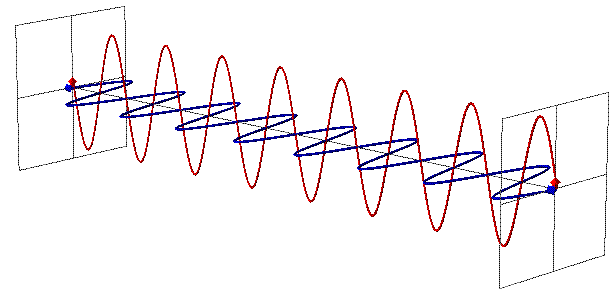
As a teaser, just as photons have E-fields and B-fields — related but distinct from one another — the polarization signature can show up as either E-modes or B-modes, or both. The recent excitement over primordial B-modes in the CMB polarization, and the potential that they’ve been definitively detected, deserve widespread notoriety. They will provide the most direct pathway yet for accessing information about the energy involved in inflation, one of the earliest stages in our Universe’s history that has shown its signature in several other observed quantities. B-modes are only one part of the polarization story, and a full description of this cosmological observable that is on the brink of some big news will be laid out here.
CMB light — going beyond the glow
To quickly recap part 1: the largest signal in CMB observations comes in the form of temperature fluctuations of the incoming light (or photons). A sea of free electrons and the photons interact very frequently (through a process called Thomson scattering), with the electrons being free because enough of the photons have enough energy to keep electrons from combining with nuclei to form neutral atoms. While being tightly tangled together due to the scattering, the electrons and photons are also bouncing into and out of very dense regions set up by clumping dark matter.

At the same time, space is expanding, which stretches the wavelength of photons causing them to lose energy. Eventually, the photons lose enough energy that electrons can combine with the nuclei, meaning Thomson scattering no longer happens, and light can start to travel unimpeded. This moment is known as recombination, and the location from which the photons are traveling is called the surface of last scattering. The egg-shaped plots often shown of CMB observations (above) are showing the hot and cold spots of the photons at the surface of last scattering across the entire sky, set up by conditions in the Universe before recombination.
But the temperature patterns are only a portion of the information encoded in physics of the Universe at that time. Additionally, the light waves also exhibit a small preferential orientation at different locations in the sky, meaning the light wave oscillates in one direction (say up and down) more than any other direction (like side to side, diagonally, etc). This orientation — the direction that one of the electromagnetic fields oscillates in — is the light wave’s polarization.
Polarization
Polarization, in some ways, is easier to think about than temperature. Polarization of CMB photons at the surface of last scattering is produced only from Thomson scattering, rather than a complicated mix of scattering and oscillation set up by collapse into dense dark matter regions and outward photon pressure as is the case for the temperature. In other words, despite accounting for so much of the Universe, dark matter has no effect on the polarization of CMB photons*.

To understand how Thomson scattering produces polarized photons, we have to understand what’s happening ‘under the hood’ in the process. Like almost all concepts in physics, the common explanation of Thomson scattering as two objects colliding is an incomplete description for what’s actually going on. For a more complete description, we need to know three things:
- photons are comprised of an electric and magnetic field,
- electrons are accelerated into motion when they’re under the influence of an electric field, and
- as electrons accelerate, they emit photons most often at a 90 degree angle to the direction they’re moving.
In the context we’re concerned with, an incoming CMB photon is absorbed by an electron, and the electron is accelerated in the direction of the photon’s electric field. This makes the electron emit a new photon with its electric field oriented in a particular direction, but with the same frequency as the incoming photon. This is precisely what polarized light is: photons from a region that, on average, have their electric fields oriented in one particular direction.
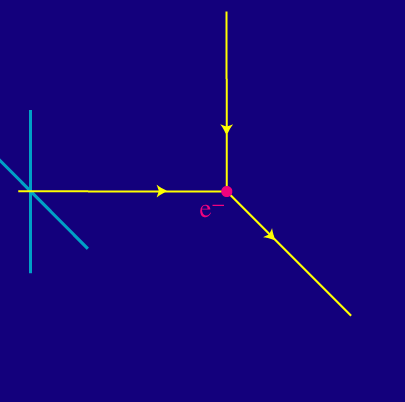
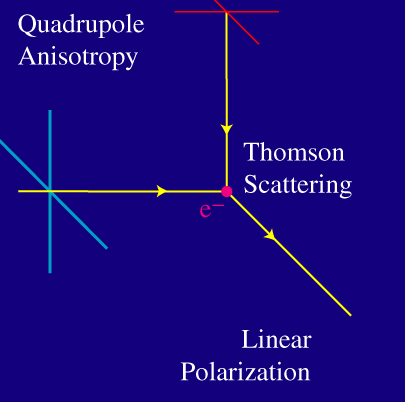
This in itself isn’t enough to produce polarization in the CMB, however. We also need a very specific configuration of the electron and incoming photons, where an electron “sees” hotter photons above and below it, while seeing colder photons to the right and left. This type of pattern, hot spot opposite hot spot and cold spot opposite cold spot, is known in more mathy terms as a quadrupole.

When a quadrupole pattern in the CMB exists around an electron, the incoming photons from the hot spots accelerate the electron more than the incoming photons from the cold spots. The light that is re-emitted from the electron is therefore polarized, since it will have an electric field with most of its strength in line with the hot spots than the cold spots. It also turns out that quadrupole is the only pattern that will produce polarization: more complicated configurations of hot and cold spots will not lead to an overall observed polarization in the CMB.
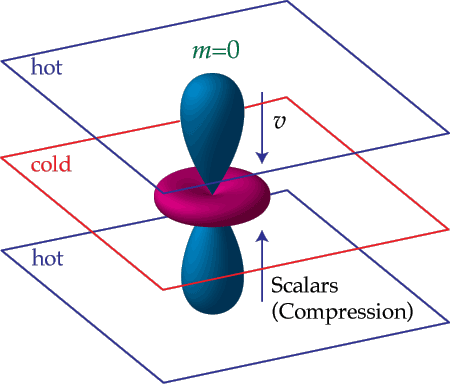

Whew. Okay, to recap the process:
- Photons are made up of electric and magnetic fields, and they accelerate an electron when the two interact.
- Because the electron is accelerating, it emits a new photon.
- Quadrupole patterns seen by an electron (hot spots above and below and cold spots to right and left, for example) accelerate the electron in such a way that the re-emitted photons are polarized.
- And finally, Quadrupoles seen by an electron are the only patterns that lead to observable polarization in the CMB.
Setting Up Quadrupoles
Now we know we need quadrupoles in the CMB in order to produce observable polarization. How do we get them? It turns out that there are two main mechanisms for producing a quadrupole pattern: density fluctuations and gravitational waves.
The density fluctuations are precisely the mechanism that help set up the temperature pattern we observe. They are the dense regions of clumpy dark matter (and to a lesser extent, normal matter) that make photons and electrons collapse inward under their gravitational influence. In part 1 of this story, we already outlined how this works to produce hot and cold spots. So, where there are temperature fluctuations, there should also be polarization fluctuations.


Gravitational waves produce quadrupoles in a different way, by stretching and contracting space itself as they travel. The images above show how a ring of particles would be affected by a traveling gravitational wave. The wavelength of light is also modified by these deformations, causing a photon to look hotter if it is in an area that is contracted and colder if in an area that’s stretched. Looking at these images, it’s easy to see how this leads to hot spots above and below and cold spots on the right and left.

What about those B-modes?
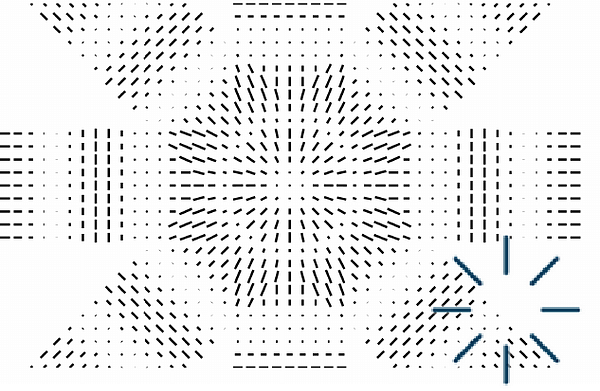
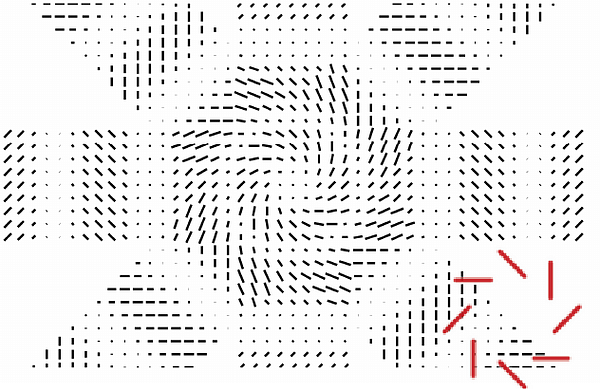
A specific type of polarization, B-modes, have been given a lot of press lately. How do they relate to the polarization described above?
Any polarization field on the sky can be split into two pieces: a piece where the patterns radiate directly out of or around a central point (E-modes), and a piece where the patterns swirl to the right or left around a central point (B-modes). The image above shows what these patterns look like**.
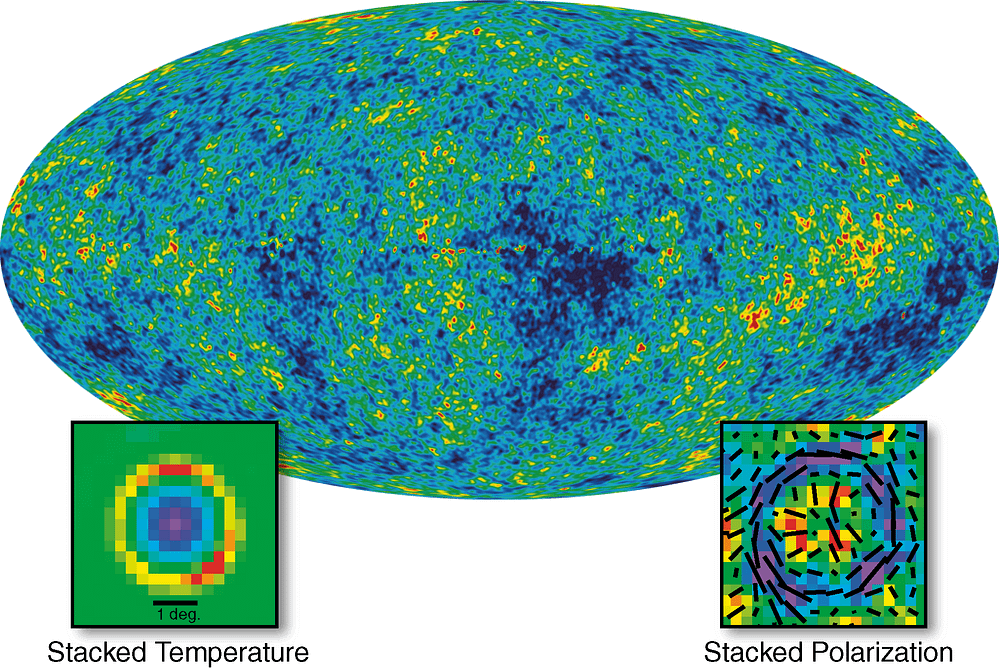
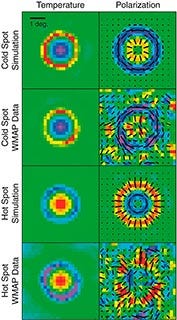
Of the mechanisms above, density fluctuations — where you get a quadrupole configuration of hot-and-cold spots around an electron — work to produce an E-mode pattern only, while gravitational waves — the stretching of rings — produce both E- and B-mode patterns. To flip this around, B-mode patterns in the CMB polarization are only produced by gravitational waves***, while E-mode patterns are generated by both gravitational waves and density fluctuations. Because the density fluctuations have a much stronger influence on the photons than the gravitational waves, the E-mode signal is expected to be dominated by density effects, something consistent with what we see. This is why measuring B-modes is the main goal of experimenters hoping to catch a glimpse of primordial gravitational waves in the CMB.
Going forward, trying to detect B-modes is a priority for the cosmology community. Earlier this year, the BICEP2 team claimed to have discovered primordial B-modes, but that analysis has been thrown into doubt, and follow-up observations are needed. Several polarization experiments are going to weigh in, from the Planck results that will (hopefully) be released sometime late this year, to EBEX, SPTPol, Spider and several others. (Not-so) fun fact: Spider is on its way to Antarctica to start its observations this November. It was originally scheduled to collect data last November, but the sequestration of the U.S. government shut down all flights into the Antarctic base and caused the team to miss their deployment window.
Needless to say, there will be lots of news regarding polarization in the coming months! As more light is shed on the nature of our early Universe, we may yet find the most subtle signature of all in the leftover glow from the Big Bang: ripples in the fabric of space itself!
*Polarization can also be induced by gravitational lensing, though this is due to physics of dark matter and galaxy clusters between us and the CMB. In this article, I’ll be focusing on polarization at the surface of last scattering.
**A technical detail for anyone who might remember undergraduate electricity and magnetism — the pattern that radiates is curl free and the pattern that swirls is divergence free. The E- and B-mode names come from an analog to the E and B fields that appear in Maxwell’s Equations in a vacuum, where the E field has no curl and the B field has no divergence.
***Again, this is only true at the surface of last scattering. B-modes are created by lensing of CMB photons as they travel to us, and non-CMB photons mixed in with the CMB photons can pollute the B-modes as well. It’s important to be very careful!
This article was written by Amanda Yoho, a graduate student in theoretical and computational cosmology at Case Western Reserve University. You can reach her on Twitter at @mandaYoho. You can catch up on Part 1 here, and come back soon for Amanda’s report on the Planck polarization results when they’re released!
Leave your comments at the Starts With A Bang forum on Scienceblogs!





